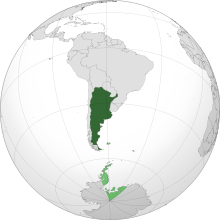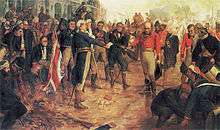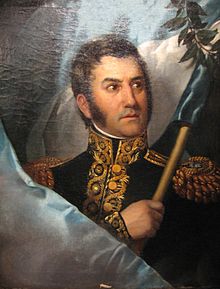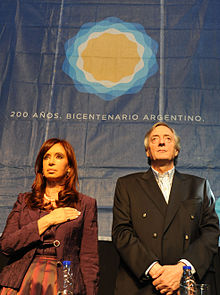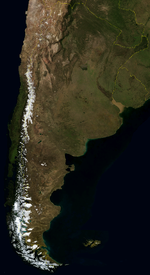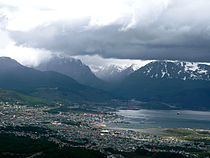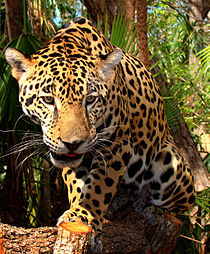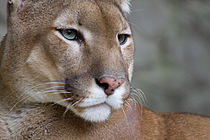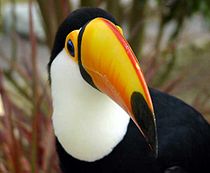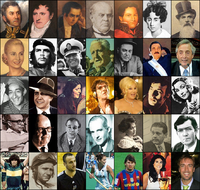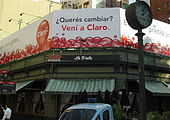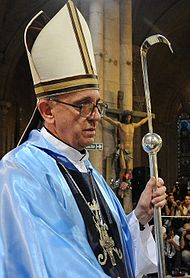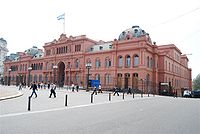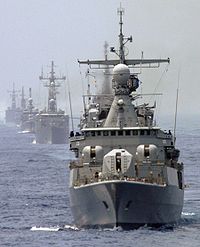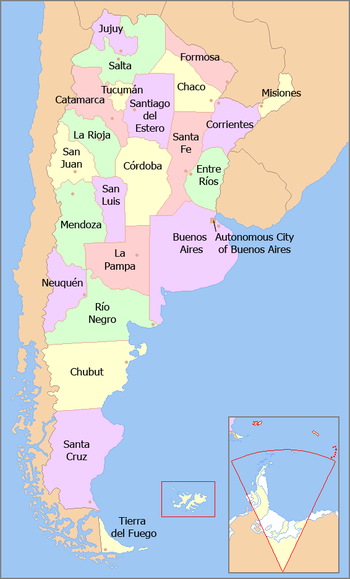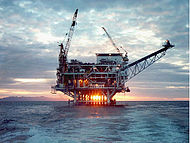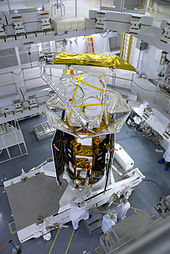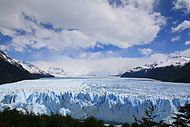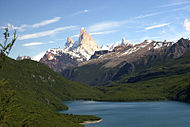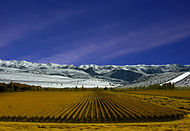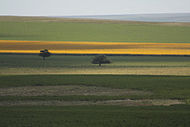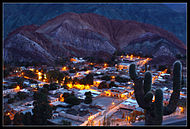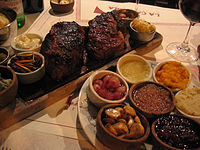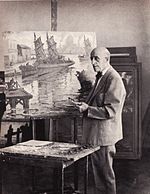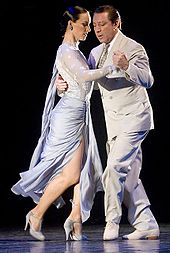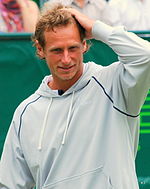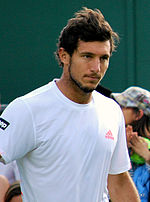
Argentina
About this schools Wikipedia selection
The articles in this Schools selection have been arranged by curriculum topic thanks to SOS Children volunteers. Do you want to know about sponsoring? See www.sponsorachild.org.uk
| Argentine Republic República Argentina (Spanish)
|
||||||
|---|---|---|---|---|---|---|
|
||||||
| Motto: " En unión y libertad" (Spanish) "In Unity and Freedom" |
||||||
| Anthem: Himno Nacional Argentino (Spanish) Argentine National Anthem |
||||||
|
Argentina shown in dark green, with territorial claims shown in light green. |
||||||
| Capital and largest city |
Buenos Aires 34°36′S 58°23′W |
|||||
| Official languages | Spanish | |||||
| Ethnic groups () |
|
|||||
| Demonym |
|
|||||
| Government | Federal presidential constitutional republic | |||||
| - | President | Cristina Fernández de Kirchner | ||||
| - | Vice President | Amado Boudou | ||||
| - | Supreme Court President | Ricardo Lorenzetti | ||||
| Legislature | Congress | |||||
| - | Upper house | Senate | ||||
| - | Lower house | Chamber of Deputies | ||||
| Independence from Spain | ||||||
| - | May Revolution | 25 May 1810 | ||||
| - | Declared | 9 July 1816 | ||||
| - | Current constitution | 1 May 1853 | ||||
| Area | ||||||
| - | Total | 2,780,400 km2 ( 8th) 1,073,518 sq mi |
||||
| - | Water (%) | 1.57 | ||||
| Population | ||||||
| - | 2012 estimate | 41,281,631 or 42,192,500 |
||||
| - | 2010 census | 40,117,096 ( 32nd) | ||||
| - | Density | 15.17/km2 ( 207th) 39.30/sq mi |
||||
| GDP ( PPP) | 2012 estimate | |||||
| - | Total | $746.927 billion ( 22nd) | ||||
| - | Per capita | $18,205 ( 51st) | ||||
| GDP (nominal) | 2012 estimate | |||||
| - | Total | $474.812 billion ( 27th) | ||||
| - | Per capita | $11,572 ( 62nd) | ||||
| Gini (2009) | 45.8 medium |
|||||
| HDI (2013) | very high · 45th |
|||||
| Currency | Peso ( $) ( ARS) |
|||||
| Time zone | ART ( UTC−3) | |||||
| Date format | dd.mm.yyyy ( CE) | |||||
| Drives on the | rightb | |||||
| Calling code | +54 | |||||
| ISO 3166 code | AR | |||||
| Internet TLD | .ar | |||||
| a. | Including Mestizo and Amerindians. | |||||
| b. | Trains ride on left. | |||||
Argentina / ˌ ɑr dʒ ən ˈ t iː n ə /, officially the Argentine Republic (Spanish: República Argentina [reˈpuβlika aɾxenˈtina]), is located in South America, bordered by Chile to the west and south, Bolivia and Paraguay to the north and Brazil and Uruguay to the northeast. Argentina claims sovereignty over part of Antarctica, the Falkland Islands (Spanish: Islas Malvinas) and South Georgia and the South Sandwich Islands.
The country is a federation of 23 provinces and the autonomous city of Buenos Aires, its capital and largest city. It is the eighth-largest country in the world by land area and the largest among Spanish-speaking nations. Argentina is a founding member of the United Nations, Mercosur, the Union of South American Nations, the Organization of Ibero-American States, the World Bank Group and the World Trade Organization, and is one of the G-15 and G-20 major economies.
A recognized Southern Cone power, and middle power, Argentina is Latin America's third-largest economy, with a "very high" rating on the Human development index. Within Latin America, Argentina has the fifth highest nominal GDP per capita and the highest in purchasing power terms. The Legatum Institute have argued that the country has a "foundation for future growth due to its market size, levels of foreign direct investment, and percentage of high-tech exports as share of total manufactured goods", and it is classed by investors as middle emerging economy.
History
Etymology
Argentina is derived from the Latin argentum ("silver"). La Plata Basin does not have any sources of silver, but the first Spanish conquerors arrived in the area following rumors of the existence of silver mountains, hence the name. The first use of the name Argentina can be traced to La Argentina, a 1602 poem by Martín del Barco Centenera. Although this name for the La Plata Basin was already in common usage by the 18th century, the area was formally called Viceroyalty of the Río de la Plata, and United Provinces of the Río de la Plata after independence.
The first formal use of the name was in the 1826 constitution, which used both the terms "Argentine Republic" and "Argentine Nation". The Constitution was repealed, and the territories were instead known as the " Argentine Confederation". This name was used in the 1853 Constitution, being changed to that of the "Argentine Nation" in 1859, and to the "Argentine Republic" per an 1860 decree, when the country achieved its current organization.
In the English language, the country was traditionally called "the Argentine", mimicking the typical Spanish usage la Argentina. This fell out of usage in English during the mid to late 20th century, and now the country is simply referred to as "Argentina".
Pre-Columbian era
The area now known as Argentina was relatively sparsely populated until the period of European colonization. The earliest traces of human life are dated from the Paleolithic period, and there are further traces in the Mesolithic and Neolithic. However, large areas of the interior and piedmont were apparently depopulated during an extensive dry period between 4000 and 2000 B.C.
The Uruguayan archaeologist Raúl Campá Soler divided the indigenous peoples in Argentina into three main groups: basic hunters and food gatherers, without development of pottery, advanced hunters and food gatherers, and farmers with pottery. The second group could be found in the Pampa and south of Patagonia, and the third one included the Charrúas and Minuane people and the Guaraníes.
Some of the different groups included the Onas at Tierra del Fuego, the Yámana at the archipelago between the Beagle Channel and Cape Horn, Tehuelches in the Patagonia, many peoples at the litoral, guaycurúes and wichis at Chaco. The Guaraníes had expanded across large areas of South America, but settled at the northeastern provinces of Argentina. The Toba (Komlek) nation and the Diaguita which included the Calchaqui and the Quilmes lived in the North and the Comechingones in what is today the province of Cordoba. The Charrua (which included the Minuane people), yaros, Bohanes and Chanás (and Chaná-Timbú) were located in the actual territory of Entre Ríos and the Querandí in Buenos Aires.
Spanish colonial era
Europeans first arrived in the region with the 1502 voyage of Amerigo Vespucci. The Spanish navigator Juan Díaz de Solís visited the territory which is now Argentina in 1516. In 1536 Pedro de Mendoza established a small settlement at the modern location of Buenos Aires, which was abandoned in 1541.
A second one was established 1580 by Juan de Garay, and Córdoba in 1573 by Jerónimo Luis de Cabrera. Those regions were part of the Viceroyalty of Peru, whose capital was Lima, and settlers arrived from that city. Unlike the other regions of South America, the colonization of the Río de la Plata estuary was not influenced by any gold rush, since it lacked any precious metals to mine.
The first European explorer, Juan Díaz de Solís, arrived on the Río de la Plata in 1516. Spain established the Viceroyalty of Peru, encompassing all its holdings in South America. Buenos Aires was established in 1536 but was destroyed by natives. The city was established again in 1580. The colonization of modern Argentina came from 3 different directions: from Paraguay, establishing the Governorate of the Río de la Plata, from Peru and from Chile.
The natural ports on the Río de la Plata estuary could not be used because all ships were meant to be made through the port of Callao near Lima, a condition that led to contraband becoming the normal means of commerce in cities such as Asunción, Buenos Aires, and Montevideo.
The Spanish raised the status of this region by establishing the Viceroyalty of the Río de la Plata in 1776. This viceroyalty consisted of today's Argentina, Uruguay, and Paraguay, as well as much of present-day Bolivia. Buenos Aires, now holding the customs of the new political subdivision, became a flourishing port, as the revenues from the Potosí, the increasing maritime activity in terms of goods rather than precious metals, the production of cattle for the export of leather and other products, and other political reasons, made it gradually become one of the most important commercial centers of the region.
The viceroyalty was, however, short-lived due to lack of internal cohesion among the many regions of which it was constituted and lack of Spanish support. Ships from Spain became scarce again after the Spanish defeat at the battle of Trafalgar, that gave the British maritime supremacy. The British tried to invade Buenos Aires and Montevideo in 1806 and 1807, but were defeated both times by Santiago de Liniers. Those victories, achieved without help from mainland Spain, boosted the confidence of the city.
The beginning of the Peninsular War in Spain and the capture of the Spanish king Ferdinand VII created great concern all around the viceroyalty. It was considered that, without a King, people in America should rule themselves. This idea led to multiple attempts to remove the local authorities at Chuquisaca, La Paz, Montevideo and Buenos Aires, all of which were short-lived. A new successful attempt, the May Revolution, took place when it was reported that all of Spain had been conquered, with the only exception of Cádiz and León.
Buenos Aires became the capital of the Viceroyalty of the Río de la Plata in 1776, with territories from the Viceroyalty of Peru. Buenos Aires and Montevideo resisted two ill-fated British invasions in 1806 and 1807. The resistance was headed both times by the French Santiago de Liniers, who would become viceroy through popular support. The ideas of the Age of Enlightenment and the example of the Atlantic Revolutions generated criticism to the Absolute monarchy. The overthrow of the Spanish King Ferdinand VII during the Peninsular War created great concern in the Americas, so many cities deposed the monarchic authorities and appointed new ones, working under the new political ideas. This started the Spanish American wars of independence across the continent. Buenos Aires deposed the viceroy Baltasar Hidalgo de Cisneros in 1810, during the May Revolution.
Independence and civil wars
| Historical states in present-day Argentina |
|||||||||||||||
|---|---|---|---|---|---|---|---|---|---|---|---|---|---|---|---|
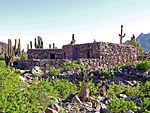 |
|||||||||||||||
|
|||||||||||||||
|
|||||||||||||||
|
|||||||||||||||
|
|||||||||||||||
|
|||||||||||||||
|
|||||||||||||||
|
more |
|||||||||||||||
The May Revolution of 1810 began the Argentine War of Independence between patriots and royalists. The Primera Junta, the new government in Buenos Aires, sent military campaigns to Córdoba, Upper Peru and Paraguay, and supported the rebellions at the Banda Oriental. The military campaigns were defeated, so Buenos Aires signed an armistice with Montevideo. Paraguay stayed Non-interventionist during the remainder of the conflict, Upper Peru defeated further military campaigns, and the Banda Oriental would be captured by William Brown during renewed hostilities. The national organization, either under a centralized government located in Buenos Aires or as a federation, began the Argentine Civil Wars as well, with the conflicts of Buenos Aires and José Gervasio Artigas.
The Argentine Declaration of Independence was issued by the Congress of Tucumán in 1816. Martín Miguel de Güemes kept royalists at bay on the North, while José de San Martín made the Crossing of the Andes, securing the independence of Chile. With the Chilean navy at his disposal he then took the fight to the royalist stronghold of Lima. San Martín's military campaigns complemented those of Simón Bolívar in Gran Colombia and led to the independent's victory in the Spanish American wars of independence.
The 1820 Battle of Cepeda, fought between the Centralists and the Federalists, resulted in the end of the centralized national authority. A new centralist constitution was enacted in 1826, during the War with Brazil, and Bernardino Rivadavia was appointed the first President of Argentina. It was rejected by the provinces, forcing Rivadavia to resign. The new governor Manuel Dorrego was deposed and executed by Juan Lavalle, which exacerbated the civil war. Juan Manuel de Rosas organized the resistance against Lavalle and restored the deposed authorities. The provinces then reorganized themselves as a loose confederation of provinces that lacked a common head of state. They would instead delegate some important powers to the governor of Buenos Aires Province, such as debt payment or the management of international relations.
Juan Manuel de Rosas ruled from 1829 to 1832, and from 1835 to 1852. During his first term he convened the Federal pact and defeated the Unitarian League. After 1835 he received the " Sum of public power". He faced several a French blockade from 1838 to 1840, the War of the Confederation in the north, an Anglo-French blockade from 1845 to 1850, and the Corrientes province revolt. Rosas remained undefeated during this series of conflicts and prevented further loss of national territory. His refusal to enact a national constitution, pursuant to the Federal pact, led to Entre Ríos governor Justo José de Urquiza to turn against Rosas and sanction the Constitution of Argentina of 1853. Rejecting it, Buenos Aires seceded from the Confederation and became the State of Buenos Aires. The war between both lasted nearly a decade, and ended with the victory of Buenos Aires at the battle of Pavón.
Buenos Aires rejoined the Confederation, and Bartolomé Mitre was elected the first president of the unified country in 1862. He began military campaigns against both the remaining federals in Argentina, the whites from Uruguay, and Paraguay. The War of the Triple Alliance, in alliance with Uruguay and Brazil, left over 300,000 dead and devastated Paraguay. Unable to influence the election of later presidents, Domingo Faustino Sarmiento and Nicolás Avellaneda followed him. Albeit unitarians, they were not from Buenos Aires, and had conflicts with him. Mitre attempted twice to secede Buenos Aires from the country once more, but failed. Avellaneda federalized Buenos Aires, after defeating a final failed attempt to secede it.
Since the colonial times, huge territories were under the control of indigenous peoples. All governments since then attempted in some way to stay in good terms, kill them, or push them to ever farther frontiers. The final conflict was the Conquest of the Desert, waged by Julio Argentino Roca in the 1870s. With this military operation, Argentina seized control of Patagonia.
Rise of Peronism
The bases of modern Argentina were established by the Generation of '80, a political movement that opposed Mitre and sought to industrialize the country. A wave of European immigration led to the strengthening of a cohesive state, the development of modern agriculture and to a near-reinvention of Argentine society and economy. The country emerged as one of the ten richest countries in the world, benefiting from an agricultural export-led economy as well as British and French investment. Driven by immigration and decreasing mortality the Argentine population grew fivefold and the economy 15-fold. However, the National Autonomist Party (PAN) could not meet its original goals of industrialization, and the country stayed as a pre-industrial society. President Juárez Celman faced an economic crisis that generated popular discontent and the Revolution of the Park in 1890, led by the Civic Union. With the resignation of Mitre, the Civic Union became the Radical Civic Union (UCR). Although the Coup d'état failed, Celman resigned from the presidency, starting the decline of the PAN. Conservative élites dominated Argentine politics until 1912, when President Roque Sáenz Peña enacted universal male suffrage and the secret ballot. This allowed the UCR to win the country's first free elections in 1916. President Hipólito Yrigoyen enacted social and economic reforms and extended assistance to family farmers and small businesses. Argentina stayed neutral during World War I.
The second administration of Yrigoyen faced a huge economic crisis, influenced by the international Great Depression. The military made a coup d'état and ousted him from power, which began the Infamous Decade. José Félix Uriburu led the military rule for two years. Agustín Pedro Justo was elected with electoral fraud, and signed the Roca-Runciman Treaty. Roberto María Ortiz and Ramón Castillo stayed neutral during World War II. Britain supported the Argentine neutrality, but after the attack on Pearl Harbour the United States requested all of South America to join the Allied Nations. Castillo was finally deposed by the Revolution of '43, a new military coup that wanted to end the electoral fraud of the last decade. Argentina declared war to the Axis Powers a month before the end of World War II in Europe. The minister of welfare of the military, Juan Perón, became highly popular among workers. He was fired and jailed, but a massive demonstration forced his liberation. Perón ran for the presidency in 1946, and won by 53.1%.
The Argentine military, as has been the tendency in other Latin American countries, were considerably more influential in former times. Starting in 1930 and throughout the 20th century, democratic governments were more often than not interrupted by military coups (see History of Argentina). The terrible consequences of the last dictatorship destroyed the military image as the moral reserve of the nation and opened the way to transform them to into today's armed forces.
Granaderos, the cavalry unit that, among other feats, followed San Martín across the Andes in 1817 to liberate Chile and Peru.
Juan Perón created a political movement known as Peronism. Taking advantage of the import substitution industrialization and the European devastation left by the immediate aftermath of World War II, he nationalized strategic industries and services, improved wages and working conditions, paid the full external debt and achieved nearly full employment. The economy, however, began to decline in 1950. His wife Eva Perón was highly popular and played a central political role, mostly through the Eva Perón Foundation, where she developed an unprecedented social assistance to the most vulnerable sectors of society in Argentina. Also provided assistance to countries of South America and she brought food and clothing to Europe, during the European Tour of Eva in 1947. The Female Peronist Party, as women's suffrage was granted in 1947. However, her declining health did not allow her to run for the vice-presidency in 1951, and she died of cancer the following year. The military began to plot against Perón in 1955, and bombed the Plaza de Mayo in an ill-fated attempt to kill him. A few months later, Perón resigned during a new military coup, which established the Revolución Libertadora. Perón left the country, and finally settled in Spain.
The Dirty War
Pedro Eugenio Aramburu proscribed Peronism and banned all manifestations of it. Peronism, however, did not disappear, as Peronists kept being organized in informal associations. The 1949 amendment of the Constitution was repealed, restoring the one of 1853; but the elections for the Constituent Assembly obtained a majority of blank votes because of the Peronist proscription. Arturo Frondizi from the UCR became popular by opposing the military rule, and got elected in the following elections. The military, however, was reluctant to allow Peronism to influence the new government, and allowed him to take power on condition he stayed aligned with them. The military frequently interfered on behalf of conservative, agrarian interests however, and the results were mixed. His policies encouraged investment to make the country self-sufficient in energy and industry, helping reverse a chronic trade deficit for Argentina. His efforts to stay on good terms with both Peronists and the military, without fully supporting either one, earned him the distrust and rejection of both. Frondizi lifted the Peronist proscription, leading to a Peronist victory in several provinces, rejected by the military. A new coup ousted him from power, but a swift reaction by José María Guido (president of the Senate) applied the laws related to power vacuums and became president instead of the military. The elections were repealed and Peronism proscribed again. Arturo Illia was elected in 1963 but, despite prosperity, his attempts to include Peronists in the political process resulted in the armed forces retaking power in a coup in 1966. The Argentine Revolution, the new military government, sought to rule in Argentina indefinitely.
The new military Junta appointed Juan Carlos Onganía as president. He closed the Congress, banned all political parties and dismantled all student unions and many worker unions. Popular discontent led to two massive protests in 1969, the Cordobazo in Córdoba and the Rosariazo in Rosario. In May 1970, the Montoneros kidnapped and executed the former de facto president, Aramburu. There was a public outcry against this crime. Onganía was replaced by Roberto M. Levingston in June 1970.
The Montoneros and the People's Revolutionary Army (ERP), commenced Guerrilla warfare against the military, ultimately resulting in 6,000 casualties. This, in turn, led to the military reacting with the Dirty War, in which 10,000 people "disappeared", including some guerillas.
In March 1971, Levingston was then replaced by Alejandro Agustín Lanusse, who began negotiations to return to democracy and end the proscription of Peronism. Initially, he sought to allow Peronism but not the return of Juan Perón himself (who was living in Spain) with an agreement stipulating presidential candidates reside in Argentina as of 25 August. Thus, the Peronist candidate was not Perón but Héctor José Cámpora, who won the elections by the 49.59%.
The return of Peronism to power saw violent disputes between its internal factions: right-wing union leaders and left-wing youth from Montoneros. The return of Perón to the country in June 1973 generated an armed conflict, the Ezeiza massacre. Overwhelmed by political violence, Cámpora and his vice-president resigned, promoting new elections so Perón could become president. Perón was elected, with his wife Isabel as vice-president. Before Peron took office the Montoneros murdered the union leader José Ignacio Rucci, with close ties to Perón. Perón expelled them from Plaza de Mayo and from the party, and they became once again a clandestine organization. José López Rega organized the Argentine Anticommunist Alliance (AAA) to fight against them and the ERP. Perón died in July 1974. His wife succeeded him. The AAA maintained operations against the guerrillas, which increased their power. The Operativo Independencia stopped a guerilla attempt to capture and secede territories of Tucumán from Argentina. A decree ordered the military to "annihilate the subversion". The military made another coup d'état, in March 1976.
The National Reorganization Process closed the Congress, removed the members of the Supreme Court, and banned political parties, unions, student unions, etc. It also intensified measures against the ERP and the Montoneros, who had kidnapped and murdered people almost weekly since 1970. The military resorted to the forced disappearance of suspected members of the guerrillas, and began to prevail in the war. The losses of Montoneros by the end of 1976 were near 2000. The Junta tried to increase its popularity with the Beagle conflict and the 1978 FIFA World Cup. As of 1977, the ERP was completely defeated. Montoneros was severely weakened, but launched a massive counterattack in 1979. It was defeated, ending the guerrilla threat, but the military Junta stayed in government. Leopoldo Galtieri launched the Falklands War (Spanish: Guerra de Malvinas), attempting to annex the islands, but within two months Argentina was defeated by the United Kingdom which considered the islands to be part of its own overseas territory. Galtieri left the government because of the military defeat, and Reynaldo Bignone began to organize the transition to democratic rule, with the free elections in 1983.
Contemporary era
In the 1983 electoral campaign Alfonsín called to national unity, restoration of democratic rule and prosecution of those responsible for the dirty war. He established the National Commission on the Disappearance of Persons (CONADEP) to investigate the forced disappearances. The CONADEP generated a report detailing 340 centers of illegal detentions and 8961 forced disappearances. The 1985 Trial of the Juntas sentenced all the heads of government of those years. Alfonsín aimed then to the military of lower ranks, but the discontent among the military and the risk of a new coup increased. To please them, he issued the full stop law, which established a deadline for new trials. This did not work as intended, and the Carapintadas mutinied, forcing the law of Due Obedience that exempted the military that followed orders from superior ranks. This reduced public support for the government, as well as an economic crisis that led to an hyperinflation. The Peronist Carlos Menem won the 1989 elections, but riots caused by the economic crisis forced Alfonsín to resign, handing government to Menem.
Carlos Menem led a change in Peronism, which declined its usual politics and embraced neoliberalism instead. A fixed exchange rate established in 1991, the dismantling of protectionist barriers, business regulations and several privatizations normalized the economy for a time. His victories at the 1991 and 1993 elections led to the 1994 amendment of the Argentine Constitution, which allowed him to run for a second term. He was reelected, but the economy began to decline in 1996, with higher unemployment and recession. He lost the 1997 elections, and the UCR returned to the presidency in the 1999 elections.
President Fernando de la Rúa sought to change the political style of Menem, but kept his economic plan regardless of the growing recession. He appointed Domingo Cavallo, who had already been minister of economy during the presidency of Menem. The social discontent led to the appearance of piqueteros and huge blank votes in the 2001 legislative elections. A huge capital flight was responded to with a freezing of bank accounts, generating further discontent. Several riots in the country led the president to establish a state of emergency, received with more popular protests. The huge riots in December finally forced De la Rúa to resign.
Eduardo Duhalde was appointed president by the Legislative Assembly, and derogated the fixed exchange rate established by Menem. The economic crisis began to end by the late 2002, under the management of the minister of Economy Roberto Lavagna. The death of two piqueteros caused a political scandal that forced Duhalde to call to elections earlier. Carlos Menem got the majority of the votes, followed by Néstor Kirchner. Kirchner was largely unknown by the people, but would maintain Lavagna as minister. However, Menem declined to run for the required ballotage, which made Kirchner the new president.
Following the economic policies laid by Duhalde and Lavagna, Kirchner ended the economic crisis, getting fiscal and trade surpluses. However, he distanced from Duhalde once getting to power. He promoted as well the reopening of judicial actions against the crimes of the Dirty War. During his administration, Argentina restructured its defaulted debt with a steep discount (about 66%) on most bonds, paid off debts with the International Monetary Fund and nationalized some previously privatized enterprises. He did not run for a reelection, promoting instead the candidacy of his wife Cristina Fernández de Kirchner.
The presidency of Cristina Kirchner began with a conflict with the agricultural sector, caused by an attempt to increase the taxes over exports. The conflict was taken to the Congress, and vice-president Julio Cobos gave an unexpected tie-breaking vote against the bill. The government waged several controversies with the press, limiting the freedom of speech. Néstor Kirchner died in 2010, and Cristina Fernández was reelected in 2011.
Same-sex marriage in Argentina has been legal since July 22, 2010. A bill for legalization was approved on May 5, 2010, by the Chamber of Deputies, and on July 15, 2010, by the Senate. President Cristina Fernández de Kirchner signed it on July 21. On July 22, the law was published in the Official Gazette. Argentina became the first country in Latin America and the second in the Americas to allow same-sex marriage nationwide. It was the tenth country to allow same-sex marriage.
Geography
Argentina is situated in southern South America, with the Andes on the west and the South Atlantic Ocean to the east and south. Argentina has a total surface area (excluding the Antarctic claim and areas controlled by the United Kingdom) of 2,780,400 km2 (1,073,500 sq mi); of this, 43,710 km2 (16,880 sq mi), or 1.57%, is water. Argentina has six main regions. The Pampas are fertile lowlands located in the centre and east. The Mesopotamia is a lowland enclosed by the Paraná and Uruguay rivers, and the Gran Chaco is between the mesopotamia and the Andes. Cuyo is at the east side of the Andes, and the Argentine Northwest is at the North of it. The Patagonia is a large plateau to the south.
The highest point above sea level is in the Mendoza province at Cerro Aconcagua (6,959 m (22,831 ft)), also the highest point in the Southern and Western Hemisphere. The lowest point is Laguna del Carbón in Santa Cruz province, −105 m (−344 ft) below sea level. This is also the lowest point in South America. The easternmost continental point is northeast of Bernardo de Irigoyen, Misiones, the westernmost in the Perito Moreno National Park in Santa Cruz province. The northernmost point is at the confluence of the Grande de San Juan and Mojinete rivers in Jujuy province, and the southernmost is Cape San Pío in Tierra del Fuego.
The major rivers are the Paraná (the largest), the Pilcomayo, Paraguay, Bermejo, Colorado, Río Negro, Salado and the Uruguay. The Paraná and the Uruguay join to form the Río de la Plata estuary, before reaching the Atlantic. Regionally important rivers are the Atuel and Mendoza in the homonymous province, the Chubut in Patagonia, the Río Grande in Jujuy and the San Francisco River in Salta.
The 4,725 km (2,936 mi) long Atlantic coast varies between areas of sand dunes and cliffs. The continental platform, the Patagonian Shelf, is unusually wide; this shallow area of the Atlantic is called the Argentine Sea. The two major ocean currents affecting the coast are the warm Brazil Current and the cold Falkland Current. Because of the unevenness of the coastal landmass, the two currents alternate in their influence on climate and do not allow temperatures to fall evenly with higher latitude. The southern coast of Tierra del Fuego forms the north shore of the Beagle Channel.
Climate
The generally temperate climate ranges from subtropical in the north to subpolar in the far south. The north is characterized by very hot, humid summers with mild drier winters, and is subject to periodic droughts. Central Argentina has a temperate climate, with hot summers with thunderstorms, and cool winters; and higher moisture at the east. The southern regions have warm summers and cold winters with heavy snowfall, especially in mountainous zones.
Major wind currents include the cool Pampero Winds blowing on the flat plains of Patagonia and the Pampas; following the cold front, warm currents blow from the north in middle and late winter, creating mild conditions. The Zonda, a hot dry wind, affects west-central Argentina. Squeezed of all moisture during the 6,000 m (19,685 ft) descent from the Andes, Zonda winds can blow for hours with gusts up to 120 km/h (75 mph), fueling wildfires and causing damage; when the Zonda blows (June–November), snowstorms and blizzard (viento blanco) conditions usually affect higher elevations. The Sudestada usually moderates cold temperatures but brings very heavy rains, rough seas and coastal flooding. It is most common in late autumn and winter along the central coast and in the Río de la Plata estuary.
Biodiversity
Subtropical plants dominate the Gran Chaco in the north, with the Dalbergia genus of trees well represented by Brazilian Rosewood and the quebracho tree; also predominant are white and black algarrobo trees ( prosopis alba and prosopis nigra). Savannah-like areas exist in the drier regions nearer the Andes. In central Argentina the humid pampas are a true tallgrass prairie ecosystem. The original pampa had virtually no trees; the only tree-like plant native to the pampa is the evergreen Ombú. The pampa is one of the most agriculturally productive on Earth; however, this is also responsible for decimating much of the original ecosystem, to make way for commercial agriculture. The western pampas receive less rainfall, this dry pampa is a plain of short grasses or steppe. The national government maintains 4 natural monuments and 33 national parks.
Prominent animals from the subtropical north include big cats like the jaguar, Most of Patagonia lies within the rain shadow of the Andes, so the flora, shrubby bushes and plants, is suited to dry conditions. The soil is hard and rocky, making large-scale farming impossible except along river valleys. Coniferous forests in far western Patagonia and on the island of Tierra del Fuego, include alerce, ciprés de la cordillera, ciprés de las guaitecas, huililahuán, lleuque, mañío hembra and pehuén, while broadleaf trees include several species of Nothofagus such as coihue, lenga and ñire. Other introduced trees present in forestry plantations include spruce, cypress and pine. Common plants are the copihue and colihue.
In Cuyo, semiarid thorny bushes and other xerophile plants abound. Along the many rivers grasses and trees grow in significant numbers. The area presents optimal conditions for the large scale growth of grape vines. In northwest Argentina there are many species of cactus.
Prominent animals from the subtropical north include big cats like the jaguar, puma, and ocelot; primates ( howler monkey); large reptiles (crocodiles), the Argentine Black and White Tegu and a species of caiman. Other animals include the tapir, peccary, capybara, bush dog, and various species of turtle and tortoise. There are a wide variety of birds, notably hummingbirds, flamingos, toucans, and swallows.
The central grasslands are populated by the giant anteater, armadillo, pampas cat, maned wolf, mara, cavias, and the rhea (ñandú), a large flightless bird. Hawks, falcons, herons, and tinamous (perdiz, Argentine "false partridges") inhabit the region. There are also pampas deer and pampas foxes. Some of these species extend into Patagonia.
The western mountains are home to different animals. These include the llama, guanaco, vicuña, among the most recognizable species of South America. Also in this region are the fox, viscacha, Andean Mountain Cat, kodkod, and the largest flying bird in the New World, the Andean Condor.
Southern Argentina is home to the cougar, huemul, pudú (the world's smallest deer), and introduced, non-native wild boar. The coast of Patagonia is rich in animal life: elephant seals, fur seals, sea lions and species of penguin. The far south is populated by cormorants.
The territorial waters of Argentina have mammals such as dolphins, orcas, and whales like the southern right whale, a major tourist draw for naturalists. Sea fish include sardines, Argentine hakes, dolphinfish, salmon, and sharks; also present are squid and King crab (centolla) in Tierra del Fuego. Rivers and streams in Argentina have many species of trout and the South American golden dorado fish. Well known snake species inhabiting Argentina include boa constrictors and a very venomous pit viper named the yarará. The Hornero was elected the National Bird after a survey in 1928.
Demographics
| Historical population | ||
|---|---|---|
| Year | Pop. | ±% p.a. |
| 1869 | 1,830,214 | — |
| 1895 | 4,044,911 | 3.05% |
| 1914 | 7,903,662 | 3.53% |
| 1947 | 15,893,827 | 2.12% |
| 1960 | 20,013,793 | 1.77% |
| 1970 | 23,364,431 | 1.55% |
| 1980 | 27,949,480 | 1.79% |
| 1991 | 32,615,528 | 1.4% |
| 2001 | 36,223,947 | 1.05% |
| 2010 | 40,091,359 | 1.13% |
| 1869 – 2001 | ||
In the 2001 census [ INDEC], Argentina had a population of 36,260,130, and preliminary results from the 2010 census were of 40,091,359 inhabitants. Argentina ranks third in South America in total population and 33rd globally. Population density is of 15 persons per square kilometer of land area, well below the world average of 50 persons. The population growth rate in 2010 was an estimated 1.03% annually, with a birth rate of 17.7 live births per 1,000 inhabitants and a mortality rate of 7.4 deaths per 1,000 inhabitants. The net migration rate has ranged from zero to four immigrants per 1,000 inhabitants.
The proportion of people under 15 is 25.6%, somewhat below the world average of 28%, and the proportion of people 65 and older is relatively high at 10.8%. In Latin America this is second only to Uruguay and well above the world average, which is currently 7%. Argentina has one of Latin America's lowest population growth rates, recently about 1% a year, as well as a comparatively low infant mortality rate. Its birth rate of 2.3 children per woman is still nearly twice as high as that in Spain or Italy, compared here as they have similar religious practices and proportions. The median age is approximately 30 years and life expectancy at birth is 77.14 years.
Ethnography
As with other areas of new settlement such as Canada, Australia, and the United States, Argentina is considered a country of immigrants. Most Argentines are descended from colonial-era settlers, and 19th and 20th century immigrants from Europe. During the 18th and 19th centuries especially, Argentina was second only to the US in the numbers of European immigrants received and, at those times, the national population doubled every two decades. The majority of these European immigrants came from Italy and Spain,. Argentina is home to a significant population of Arabic and partial Arabic background. The Asian population is the country numbers at around 180,000 individuals, most of whom are of Chinese descent.
Recent Illegal immigration has mostly been coming from Bolivia and Paraguay, with smaller numbers from Peru, Ecuador and Romania. The Argentine government estimates that 750,000 inhabitants lack official documents and has launched a program to encourage illegal immigrants to declare their status in return for two-year residence visas——so far over 670,000 applications have been processed under the program.
Language
The de facto official language of Argentina is Spanish, usually called castellano (Castilian) by Argentines. Argentina is the largest Spanish-speaking society that universally employs voseo (the use of the pronoun vos instead of tú (you), which occasions the use of alternate verb forms as well). The most prevalent dialect is Rioplatense, whose speakers are primarily located in the Río de la Plata basin. Italian and other European immigrants influenced Lunfardo, the slang spoken in the region, permeating the vernacular vocabulary of other regions as well. A phonetic study conducted by the Laboratory for Sensory Investigations of CONICET and the University of Toronto showed that the accent of the inhabitants of Buenos Aires (known as porteños) is closer to the Neapolitan language, spoken in Southern Italy, than any other spoken language.
According to Ethnologue there are around 1.5 million Italian speakers (making it the second most spoken language in the country) and 1 million speakers of the North Levantine dialect of Arabic (spoken in Syria, Lebanon and Cyprus). Standard German is spoken by 400,000—500,000 Argentines of German ancestry, making it the fourth most spoken language.
Some indigenous communities have retained their original languages. Guaraní is spoken by some in the north east, especially in Corrientes (where it enjoys official status) and Misiones. Quechua is spoken by some in the north west and has a local variant in Santiago del Estero. Aymara is spoken by members of the Bolivian immigrant community. In Patagonia there are Welsh-speaking communities with around 25,000 using it as their second-language. Recent immigrants have brought Chinese and Korean (mostly to Buenos Aires). English, Brazilian Portuguese and French are also spoken.
Religion
The Constitution guarantees freedom of religion but also requires the government to support Roman Catholicism economically. Catholic policy remains influential in government though, and still helps shape a variety of legislation. In a study assessing world-wide levels of religious regulation and persecution, with scores ranging from 0–10 where 0 represented low levels of regulation or persecution, Argentina received a score of 1.4 on Government Regulation of Religion, 6.0 on Social Regulation of Religion, 6.9 on Government Favoritism of Religion and 6 on Religious Persecution.
According to the World Christian Database Argentines are: 92.1% Christian, 3.1% agnostic, 1.9% Muslim, 1.3% Jewish, 0.9% atheist, and 0.9% Buddhist and others. Argentine Christians are mostly Roman Catholic with estimates for the number of Catholics varying from 70% to 90% of the population (though perhaps only 20% attend services regularly). On March 13, 2013, Argentine Cardinal Jorge Mario Bergoglio was elected as Pope of the Roman Catholic Church, becoming the first pope from the New World. He took the name Pope Francis.
Argentina has the largest Jewish population of any country in Latin America. A recent study found that approximately 11% of Argentines are non-religious (which includes those who believe in God but do not follow a religion), 4% are agnostics and 5% are atheist. Overall 24% attended religious services regularly. Protestants were the only group with a majority of followers who regularly attended services.
Urbanization
Argentina is highly urbanized. The ten largest metropolitan areas account for half of the population, and fewer than one in ten live in rural areas. About 3 million people live in Buenos Aires City and the Greater Buenos Aires metropolitan area totals around 13 million, making it one of the largest urban areas in the world.
The metropolitan areas of Córdoba and Rosario have around 1.3 million inhabitants each and Mendoza, Tucumán, La Plata, Mar del Plata, Salta and Santa Fe have at least half a million people each.
The population is unequally distributed amongst the provinces: about 60% live in the Pampa region (21% of the total area), including 15 million people in Buenos Aires Province; Córdoba Province Santa Fe Province and the Autonomous City of Buenos Aires have 3 million each. Seven other provinces have over one million people each: Mendoza, Tucumán, Entre Ríos, Salta, Chaco, Corrientes and Misiones. Tucumán is the most densely populated with 60 inhabitants/km², the only Argentine province more densely populated than the world average, while the southern province of Santa Cruz has around 1 inhabitant/km².
| Largest cities or towns of Argentina (2007 INDEC estimate) |
|||||||||
|---|---|---|---|---|---|---|---|---|---|
| Rank | City name | Province | Pop. | Rank | City name | Province | Pop. | ||
 Buenos Aires |
1 | Buenos Aires | (Autonomous city) | 3,050,728 | 11 | Resistencia | Chaco | 377,000 |  Rosario |
| 2 | Córdoba | Córdoba | 1,372,000 | 12 | Corrientes | Corrientes | 345,000 | ||
| 3 | Rosario | Santa Fe | 1,242,000 | 13 | Bahía Blanca | Buenos Aires | 304,000 | ||
| 4 | Mendoza | Mendoza | 885,434 | 14 | San Salvador de Jujuy | Jujuy | 298,000 | ||
| 5 | Tucumán | Tucumán | 789,000 | 15 | Posadas | Misiones | 287,000 | ||
| 6 | La Plata | Buenos Aires | 732,503 | 16 | Paraná | Entre Ríos | 268,000 | ||
| 7 | Mar del Plata | Buenos Aires | 604,563 | 17 | Neuquén | Neuquén | 255,000 | ||
| 8 | Salta | Salta | 516,000 | 18 | Santiago del Estero | Santiago del Estero | 244,733 | ||
| 9 | Santa Fe | Santa Fe | 493,000 | 19 | Merlo | Buenos Aires | 244,168 | ||
| 10 | San Juan | San Juan | 453,229 | 20 | Quilmes | Buenos Aires | 230,810 | ||
- ^ "3218.0 - Instituto Nacional de Estadistica y Censos, Argentina, 2006-07". INDEC. 2008-03-31. http://www.indec.mecon.gov.ar/nuevaweb/cuadros/4/EPHcont_1trim08.pdf. Retrieved 2008-06-06.
Government
Argentina is a constitutional republic and representative democracy. The government is regulated by a system of checks and balances defined by the Constitution of Argentina, which serves as the country's supreme legal document. The seat of government is the city of Buenos Aires, such location is regulated by the Congress. Suffrage is universal, equal, secret and mandatory.
The national government is composed of three branches:
- Legislative: The bicameral Congress, made up of the Senate and the Chamber of Deputies, makes federal law, declares war, approves treaties, has the power of the purse, and has the power of impeachment, by which it can remove sitting members of the government.
- Executive: The president is the commander-in-chief of the military, can veto legislative bills before they become law, and appoints the members of the Cabinet and other officers, who administer and enforce federal laws and policies.
- Judicial: The Supreme Court and lower federal courts, whose judges are appointed by the president with Senate approval, interpret laws and overturn those they find unconstitutional.
The Chamber of Deputies has 257 voting members, each representing a province for a four-year term. Seats are apportioned among the provinces by population every tenth year. As of 2012, ten provinces have just five deputies, while the Buenos Aires Province, the most populous province, has 70. The Senate has 72 members with each province having three senators, elected at-large to six-year terms; one third of Senate seats are up for election every other year. A third of the candidates presented by the parties must be women. The president serves a four-year term and may be elected to the office no more than twice in a row. The president is elected by direct vote. The judiciary is independent of the executive and the legislature. The Supreme Court has seven members appointed by the President in consultation with the Senate. The judges of all the other courts are appointed by the Council of Magistrates of the Nation, a secretariat composed of representatives of judges, lawyers, the Congress and the executive.
The provincial governments must be representative republics and may not contradict the national constitution and national laws, but beyond that, each province is allowed to have its own constitution and organize their local government as desired. For example, some provinces have bicameral provincial legislatures, while others have unicameral ones. Buenos Aires is not a province but a federal district, but its local organization has similarities with the provinces: it has a local constitution, an elected mayor and representatives to the Senate and the Chamber of deputies. The national government reserved control of the Argentine Federal Police (the federally administered city force), the Port of Buenos Aires, and other faculties, however.
On 1 November 2012, the voting age was lowered from 18 to 16. Voting is compulsory for Argentineans between 18 and 70, but voluntary for 16 and 17-year-olds under the new law.
Foreign relations
Argentina is a full member of the Mercosur block together with Brazil, Paraguay and Uruguay. Since 2002 Argentina has emphasized the role of Latin American integration and the bloc, which has some supranational legislative functions, as its first international priority. Argentina is a founding signatory and permanent consulting member of the Antarctic Treaty System and the Antarctic Treaty Secretariat is based in Buenos Aires. Argentina is also a full member of the Union of South American Nations. The former president of Argentina Néstor Kirchner was the first Secretary General of this organization. Argentina is part of the G-20 as well.
Argentina claims sovereignty over the Falkland Islands (Spanish: Islas Malvinas), and South Georgia and the South Sandwich Islands, which are administered by the United Kingdom as British Overseas Territories, as well as almost 1,000,000 square kilometres (390,000 sq mi) in Antarctica, between 25°W and 74°W and south of 60°S. The Antarctic claim overlaps claims by Chile and the United Kingdom, though all claims to Antarctica fall under the provisions of the Antarctic Treaty of 1961. Since 1904, a scientific post has been maintained in Antarctica by mutual agreement.
Argentina and Brazil remain major trading partners in the Southamerican region. In addition, these countries work together in making satellites orbiting over South America performing different jobs.
Argentina is currently participating in major peacekeeping operations in Haiti, Cyprus, Western Sahara and the Middle East.
Within the term of President Néstor Kirchner, from 2003 onwards, Argentina suspended its policy of automatic alignment with the United States and moved closer to other Latin American countries. Argentina no longer supports the UN Commission on Human Rights resolution criticizing the "human rights situation in Cuba" and calling upon the Government of Cuba to "adhere to international human rights norms", but has chosen instead to abstain. In the 2006 United Nations Security Council election, Argentina supported, like all Mercosur countries, the candidacy of Venezuela (a Mercosur member) over Guatemala for a non-permanent seat in the Security Council.
The Mercosur has become a central part of the Argentine foreign policy, with the goal of forming a Latin American trade block. Argentina has chosen to form a block with Brazil when it comes to external negotiations, though the economic asymmetries between South America's two largest countries have produced tension at times.
Between 4 and 5 November 2005, the city of Mar del Plata hosted the Fourth Summit of the Americas. Although the themes were unemployment and poverty, most of the discussion was focused on the FTAA. The summit was a failure in this regard, but marked a clear split between the countries of the Mercosur, plus Venezuela, and the supporters of the FTAA, led by the United States, Mexico and Canada. FTAA negotiations have effectively stalled until at least the conclusion of the 2006 Doha round global trade talks.
In 2005, Argentina assumed again the two-year non-permanent position on the UN Security Council.
As of 2007, during Kirchner's almost four years in power, Argentina entered into 294 bilateral agreements, including 39 with Venezuela, 37 with Chile, 30 with Bolivia, 21 with Brazil, 12 with the People's Republic of China, 10 with Germany, 9 with the United States and Italy, and 7 with Cuba, Paraguay, Spain and Russia.
Military

The Armed Forces are controlled by the Commander-in-Chief (the President) and a civilian Minister of Defense. In addition to the army, navy and air force, there are two forces controlled by the Interior Ministry: the Argentine National Gendarmerie, a gendarmerie used to guard borders and places of strategic importance; and the Naval Prefecture, a coast guard used to protect internal major rivers and maritime territory.
The armed forces of Argentina comprise an army, navy and air force, and number about 70,000 active duty personnel, one third fewer than levels before the return to democracy in 1983. The President is commander-in-chief of the armed forces, with the Defense Ministry exercising day-to-day control. There are also two other forces; the Naval Prefecture (which patrols Argentine territorial waters) and the National Gendarmerie (which patrols the border regions); both arms are controlled by the Interior Ministry but maintain liaison with the Defense Ministry. The age for enlistment in the volunteer military is from 16 to 23 years old.
Argentina is committed to international peacekeeping under United Nations mandates, humanitarian aid on emergencies relief and support the country's continuous presence at Antarctica.
Democratic governments since 1983 straightened the military budget and did not approve any large scale equipment purchases. Argentina military spending is one of the lowest of South America and as of 2010, its 0.9% of GDP only exceeds Suriname
Historically, Argentina's military has been one of the best equipped in the region (for example, developing its own jet fighters as early as the 1950s); but recently it has faced sharper expenditure cutbacks than most other Latin American armed forces. Real military expenditures declined steadily after 1981 and though there have been recent increases, the defense budget is now around US$3 billion.
Since 2000s, the Argentine defense industry was relaunched after the politics of privatization carried out during the 1990s by Carlos Menem administration virtually eliminated all.
Mercosur is an economic entity. However, the strengthening of confidence among the member countries has been beneficial to the peace in the region, exercising a useful role in supporting democracy. The Mercosur served, for example, to discourage the Paraguayan military from an attempted coup in early 2000.
Traditionally, Argentina maintains close defense cooperation and military-supply relationships with the United States, and to a lesser extent, with Israel, Germany, France, Spain, and Italy.
On 2007 an agreement for cooperation in peace operations was signed with France.
Argentina created with Chile a combined force for future United Nations mandates. Named Cruz del Sur (English: Crux), the new force began assembly in 2008 with headquarters alternately on each country every year.
On 2009, UNASUR, the South America countries union, created the CDS ( Spanish: Consejo de Defensa Sudamericano (South American Defence council) in order to promote cooperation and transparency between their armed forces
On 2011 they perform with Chile the PARACACH (Patrulla de Rescate Antártica Combinada Argentina-Chile, Argentine Chilean Antarctic Combined Search And Rescue Patrol) with support of the German Space Agency which provided satellite imagery
Political divisions
Argentina is composed of twenty-three provinces and one autonomous city, Buenos Aires. The administrative divisions of the Provinces are the departments, and the municipalities, except for Buenos Aires Province, which is divided into partidos. The City of Buenos Aires is divided into communes. The provinces are organized as a federation, each one with a local constitution. They hold all the power that is not specifically delegated to the national government.
During the Argentine War of Independence the main cities and their surrounding countrysides became provinces, though the intervention of their cabildos. The anarchy of the year XX completed this process, shaping the original thirteen provinces. Jujuy seceded from Salta in 1834, and the thirteen provinces became fourteen. After seceding for a decade, Buenos Aires accepted the Constitution of Argentina of 1853 in 1860. Buenos Aires was made a federal territory in 1880.
A 1862 law determined that the territories under control of Argentina but outside the frontiers of the provinces would be called national territories. This allowed in 1884 to establish the governorates of Misiones, Formosa, Chaco, La Pampa, Neuquén, Río Negro, Chubut, Santa Cruz and Tierra del Fuego. The agreement about a frontier dispute with Chile in 1900 created the national territory of Los Andes, whose territories were incorporated into Jujuy, Salta and Catamarca in 1943. La Pampa and Chaco became provinces in 1951. Misiones did so in 1953, and Formosa, Neuquén, Río Negro, Chubut and Santa Cruz in 1955. The last national territory, Tierra del Fuego, became a province in 1990.
|
|
a Not a Province. Autonomous City and seat of National Government.
(Also known as Buenos Aires City).
b Tierra del Fuego Province includes claims over Argentine Antarctica, Falkland Islands, and South Georgia and South Sandwich Islands.
Economy
The economy of Argentina is Latin America's third-largest, with a Very High Human Development Index and a relatively high GDP per capita. It is classified as an upper middle-income economy by the Wold Bank.
The country benefits from rich natural resources, a highly literate population, an export-oriented agricultural sector and a diversified industrial base. Historically, however, Argentina's economic performance has been very uneven, in which high economic growth alternated with severe recessions, particularly during the late twentieth century, and income maldistribution and poverty increased. Early in the twentieth century it was one of the richest countries in the world and the richest in the Southern hemisphere, though it is now an upper-middle income country.
Argentina is considered an emerging market by the FTSE Global Equity Index, and is one of the G-20 major economies.
High inflation has been a weakness of the Argentine economy for decades. Officially hovering around 9% since 2006, inflation has been privately estimated at over 30%, becoming a contentious issue again. The government has manipulated inflation statistics. The urban income poverty rate has dropped below the numbers of the 2001 economic crisis Income distribution, having improved since 2002, is still considerably unequal. Argentina began a period of fiscal austerity in 2012.
Argentina ranks 100th out of 178 countries in the Transparency International's Corruption Perceptions Index for 2011. Reported problems include government corruption, lack of judicial independence, huge taxes and tariffs, and regulatory interference that undermines efficiency and productivity growth. The Kirchner administration responded to the Global financial crisis of 2008–2009 with a record public-works program, new tax cuts and subsidies, and the transfer of private pensions to the social security system. Private pension plans, which required growing subsidies to cover, were nationalized to shed a budgetary drain as well as to finance high government spending and debt obligations.
Industry

Manufacturing is the largest single sector in the nation's economy (19% of GDP), and is well-integrated into Argentine agriculture, with half the nation's industrial exports being agricultural in nature. Based on food processing and textiles during its early development in the first half of the 20th century, industrial production has become highly diversified in Argentina. Leading sectors by production value are: Food processing and beverages; motor vehicles and auto parts; refinery products, and biodiesel; chemicals and pharmaceuticals; steel and aluminium; and industrial and farm machinery; electronics and home appliances. These latter include over three million big ticket items, as well as an array of electronics, kitchen appliances and cellular phones, among others. The country's auto industry produced 829,000 motor vehicles in 2011, and exported 507,000 (mainly to Brazil, which in turn exported a somewhat larger number to Argentina). Beverages are another significant sector, and Argentina has long been among the top five wine producing countries in the world; beer overtook wine production in 2000, and today leads by nearly two billion liters a year to one.
Other manufactured goods include: glass and cement; plastics and tires; lumber products; textiles; tobacco products; recording and print media; furniture; apparel and leather. Most manufacturing is organized around 280 industrial parks, with another 190 slated to open during 2012. Nearly half the industries are based in the Greater Buenos Aires area, although Córdoba, Rosario, and Ushuaia are also significant industrial centers; the latter city became the nation's leading centre of electronics production during the 1980s. The production of computers, laptops, and servers grew by 160% in 2011, to nearly 3.4 million units, and covered two-thirds of local demand. Another important rubric historically dominated by imports – farm machinery – will likewise mainly be manufactured domestically by 2014.
Construction permits nationwide covered nearly 19 million m² (205 million ft²) in 2008. The construction sector accounts for over 5% of GDP, and two-thirds of the construction was for residential buildings.
Argentine electric output totaled over 122 billion Kwh in 2009. This was generated in large part through well developed natural gas and hydroelectric resources. Nuclear energy is also of high importance, and the country is one of the largest producers and exporters, alongside Canada and Russia of cobalt-60, a radioactive isotope widely used in cancer therapy.
Science and technology
Argentina has three Nobel Prize laureates in sciences. Argentine research has led to the treatment of heart diseases and several forms of cancer. Domingo Liotta designed and developed the first artificial heart successfully implanted in a human being in 1969. René Favaloro developed the techniques and performed the world's first ever coronary bypass surgery.
Bernardo Houssay, the first Latin American awarded with a Nobel Prize in the Sciences, discovered the role of pituitary hormones in regulating glucose in animals; César Milstein did extensive research in antibodies; Luis Leloir discovered how organisms store energy converting glucose into glycogen and the compounds which are fundamental in metabolizing carbohydrates. A team led by Alberto Taquini and Eduardo Braun-Menéndez discovered angiotensin in 1939, and was the first to describe the enzymatic nature of the renin-angiotensin system and its role in hypertension. The Leloir Institute of biotechnology is among the most prestigious in its field in Latin America.
Dr. Luis Agote devised the first safe method of blood transfusion, Enrique Finochietto designed operating table tools such as the surgical scissors that bear his name ("Finochietto scissors") and a surgical rib-spreader.
Argentina's nuclear program is highly advanced, having resulted in a research reactor in 1957 and Latin America's first on-line commercial reactor in 1974. Argentina developed its nuclear program without being overly dependent on foreign technology. Nuclear facilities with Argentine technology have been built in Peru, Algeria, Australia and Egypt. In 1983, the country admitted having the capability of producing weapon-grade uranium, a major step needed to assemble nuclear weapons; since then, however, Argentina has pledged to use nuclear power only for peaceful purposes. As a member of the Board of Governors of the International Atomic Energy Agency, Argentina has been a strong voice in support of nuclear non-proliferation efforts and is highly committed to global nuclear security.
In other areas, Juan Vucetich, a Croatian immigrant, was the father of modern fingerprinting (dactiloscopy). Juan Maldacena, an Argentine-American scientist, is a leading figure in string theory. Argentine built satellites include LUSAT-1 (1990), Víctor-1 (1996), PEHUENSAT-1 (2007), and those developed by CONAE, the Argentine space agency, of the SAC series. The Pierre Auger Observatory near Malargüe, Mendoza, is the world's foremost cosmic ray observatory.
Despite its modest budget and numerous setbacks, academics and the sciences in Argentina have enjoyed an international respect since the turn of the 1900s, when Dr. Luis Agote devised the first safe and effective means of blood transfusion as well as René Favaloro, who was a pioneer in the improvement of the coronary artery bypass surgery. Argentina has three Nobel Prize winners in the sciences: Bernardo Houssay in Physiology or Medicine in 1947, Luis Federico Leloir in Chemistry in 1970, and César Milstein in Physiology or Medicine in 1984. Argentine scientists are still on the cutting edge in fields such as nanotechnology, physics, computer sciences, molecular biology, oncology, ecology, and cardiology, where Dr. Domingo Liotta created the first artificial heart in 1969, revolutionizing the heart transplant field.
They have also contributed to bioscience in efforts like the Human Genome Project, where Argentine scientists have successfully mapped the genome of a living being, a world first. Argentina has its own satellite programme, nuclear power station designs (4th generation) and public nuclear energy company INVAP, which provides several countries with nuclear reactors.
Other projects are focusing on IT, nanotechnology, biotechnology, helicopters, farming machinery and military defensive systems. Space research has also become increasingly active in Argentina. Established in 1991, the CONAE has since launched two satellites successfully and, in June 2009, secured an agreement with the European Space Agency on for the installation of a 35-m diameter antenna and other mission support facilities at the Pierre Auger Observatory. The facility will contribute to numerous ESA space probes, as well as CONAE's own, domestic research projects. Chosen from 20 potential sites and one of only three such ESA installations in the world, the new antenna will create a triangulation which will allow the ESA to ensure mission coverage around the clock.
Four out of five Argentine adults have completed grade school, over a third have completed their secondary education and one in nine Argentine adults have college degrees. Likewise, Argentina has the highest rate of university students in Latin America, besides having more within the southern hemisphere with professors and institutions awarded prestigious prizes and fellowships from philanthropic institutions like the John S. Guggenheim Foundation awards or the Howard Hughes Medical Institute, to name a few. Official sources recently reported roughly 1,500,000 college students within the Argentine University System; this represents the highest rate – relative to its total population – of academic students in Latin America and exceeds the ratio in many developed countries.
Tourism
As of 2011, Argentina is the most visited country in South America and the fourth most visited in the Americas. According to official figures from the World Tourism Organization, in 2010 the country received more than 5,300,000 foreign tourists, which meant about 4,930 million dollars of income from divisas. The World Economic Forum estimated that, in 2006 tourism generated around US$25 billion in economic turnover, and employed 1.8 million. Domestic tourism amounted to over 80% of this and tourism from abroad contributed US$ 4.3 billion, becoming the third largest source of foreign exchange in 2004. Around 4.6 million foreign visitors arrived in 2007, yielding a positive balance vis-à-vis the number of Argentines traveling abroad. Buenos Aires is in the midst of a tourism boom, according to the World Travel & Tourism Council, it reveals strong growth for Argentina Travel and Tourism in 2007 and in coming years, and the prestigious travel and tourism publication; Travel + Leisure Magazine, a monthly publication leader in the world-wide market of travel magazines, travelers voted Buenos Aires the second most desirable city to visit after Florence, Italy. Buenos Aires, regarded as the "Paris of South America," offers elegant architecture, exquisite cuisine, a legendary nightlife, and fashionable shopping. The most popular tourist sites are found in the historic city core, comprising Montserrat and San Telmo. The city was originally constructed around the Plaza de Mayo, the administrative centre of the Spanish Colony. To the east of the square is the Casa Rosada, the official seat of the executive branch of the government of Argentina. To the north, the Catedral Metropolitana which has stood in the same location since colonial times, and the Banco de la Nación Argentina building, a parcel of land originally owned by Juan de Garay. Other important colonial institutions were Cabildo, to the west, which was renovated during the construction of Avenida de Mayo and Julio A. Roca. To the south is the Congreso de la Nación (National Congress), which currently houses the Academia Nacional de la Historia (National Academy of History). Lastly, to the northwest, is City Hall.
The borough of Recoleta is home to a number of places of interest, including the Museo Nacional de Bellas Artes, the Biblioteca Nacional, the Centro Cultural Recoleta, the Faculty of Law of the Universidad de Buenos Aires, the Basílica Nuestra Señora de Pilar, the Palais de Glace, the Café La Biela and the Cementerio de la Recoleta, where Eva Perón's crypt can be visited, among those of many other Argentine historical and cultural figures.
| Tourist centres in Argentina | ||||||||||||||||||||
|
||||||||||||||||||||
Education
The education in Argentina known as the Latin American docta has had a convoluted history. There was no effective education plan until President Domingo Sarmiento (1868–1874) placed emphasis on bringing Argentina up-to-date with practices in developed countries. Sarmiento encouraged the immigration and settling of European educators and built schools and public libraries throughout the country, in a programme that finally doubled the enrollment of students during his term; in Argentina, Teacher's Day (on September 11) commemorates his death. The first national laws mandating universal, compulsory, free and secular education ( Law 1420 of Common Education) were sanctioned in 1884 during the administration of President Julio Roca. The non-religious character of this system, which forbade parochial schools from issuing official degrees directly but only through a public university, harmed the relations between the Argentine State and the Catholic Church, leading to resistance from the local clergy and a heated conflict with the Holy See (through the Papal Nuncio).
Following the university reform of 1918, Argentine education, especially at university level, became more independent of the government, as well as the influential Catholic Church. The church began to re-emerge in country's secular education system during the administration Juan Perón, when in 1947, catechism was reintroduced in public schools, and parochial institutions began again receiving subsidies. A sudden reversal in the policy in 1954 helped lead to Perón's violent overthrow, after which his earlier, pro-clerical policies were reinstated by General Pedro Aramburu. Aramburu's Law 6403 of 1955, which advanced private education generally, and parochial, or more often, Catholic-run schools (those staffed with lay techers), in particular, helped lead to the establishment of the Argentine Catholic University.
The program of deregulation and privatization pursued by President Carlos Menem in reaction to the country's socio-economic crisis of 1989 led to the decentralization of the Argentine secondary school system, whereby, from 1992 onwards, the schools' administration and funding became a provincial responsibility. The policy's weakness, however, lay in that federal revenue sharing did not increase accordingly, particularly given the decision to shift two primary school years to the secondary system.
Real government spending on education increased steadily from the return of democratic rule in 1983 (with the exception of the crises in 1989 and 2002) and, in 2007, totaled over US$14 billion. Argentina built a national public education system in comparison to other nations, placing the country high in the global rankings of literacy. Today Argentina has a literacy rate of 97,4%, and 16.2% over age 15 have completed secondary school studies or higher.
School attendance is compulsory between the ages of 5 and 17. The Argentine school system consists of an elementary or lower school level lasting six or seven years, and a secondary or high school level lasting between five to six years. In the 1990s, the system was split into different types of high school instruction, called Educacion Secundaria and the Polimodal. Some provinces adopted the Polimodal while others did not. A project in the executive branch to repeal this measure and return to a more traditional secondary level system was approved in 2006.
There are forty-seven national public universities across the country, as well as forty-six private ones. The University of Buenos Aires, Universidad Nacional de Córdoba, Universidad Nacional de La Plata, Universidad Nacional de Rosario, and the National Technological University are among the most important. Public universities faced cutbacks in spending during the 1980s and 1990s, which led to a decline in overall quality.
Infrastucture
Transport
Transport in Argentina is mainly based on a complex network of routes, crossed by relatively inexpensive long-distance buses and by cargo trucks. The country also has a number of national and international airports. The importance of the long-distance train is minor today, though in the past it was widely used. Fluvial transport is mostly used for cargo. Within the urban areas, the main transportation system is uy the bus or colectivo; bus lines transport millions of people every day in the larger cities and their metropolitan areas. Buenos Aires additionally has an underground, the only one in the country, and Greater Buenos Aires is serviced by a system of suburban trains.
A majority of people employ public transport rather than personal cars to move around in the cities, especially in common business hours, since parking can be both difficult and expensive. Cycling is not very common in big cities, as there are few bicycle-paths, making it difficult to move with them other than in recreational areas.
Since Argentina is almost 4,000 kilometres long and more than 1,000 km wide, long distance transportation is of great importance. Several toll expressways spread out from Buenos Aires, serving nearly half the nation's population. The majority of Argentine roads, however, are two-lane national and provincial routes and, though they are spread throughout the country, less than a third of Argentina's 230,000 km (145,000 mi) of roads are currently paved.
Though, by 1929, Argentina was already home to over 400,000 vehicles (more than half the total in Latin America, at the time), virtually all long-distance travel was done on the nation's vast railways. Argentina, then, lacked a road-building program until 1932, when the National Highway Directorate was established. Paid for at first with an excise tax on gasoline, the bureau could claim some important accomplishments, like the 1951 opening of the 200 km Santa Fe- Rosario expressway, Latin America's first.
Argentina is home to around 9.2 million registered cars, trucks and buses; on a per capita basis, it has long had Latin America's widest accessibility to motor vehicles. Left-lane drivers until 1945, Argentine motorists have since been driving on the right-hand side. The Vehicle registration plates of Argentina are based on a three letters-three numbers per car (with the exception of some trucks) system.
Expressways have been recently doubled in length (to nearly) and now link most (though not all) important cities. The most important of these is probably the Panamerican National Route 9 Buenos Aires– Rosario– Córdoba freeway. The longest continuous highways are National Route 40, a 5000-km stretch along the Andes range and the 3000-km sea-side trunk road National Route 3, running from Buenos Aires to Ushuaia.
Argentine long distance buses are fast, affordable and comfortable; they have become the primary means of long-distance travel since railway privatizations in the early 1990s greatly downsized Argentina's formerly ubiquitous passenger rail service. Competing providers differ little on their time-honoured formula, offering three different services regarding the number of stops and type of seats: the Regular, Semi-cama (semi-bed), and Cama (bed), with Cama being similar to an airline's business class. Some services have also on-board dining, while others stop at restaurants by the road. Long and middle-distance buses cover almost all paved-accessible cities, towns and villages.
Health care
Health care is provided through a combination of employer and labor union-sponsored plans (Obras Sociales), government insurance plans, public hospitals and clinics and through private health insurance plans. Health care cooperatives number over 300 (of which 200 are related to labor unions) and provide health care for half the population; the national INSSJP (popularly known as PAMI) covers nearly all of the five million senior citizens.
There are more than 153,000 hospital beds, 121,000 physicians and 37,000 dentists (ratios comparable to developed nations). The relatively high access to medical care has historically resulted in mortality patterns and trends similar to developed nations': from 1953 to 2005, deaths from cardiovascular disease increased from 20% to 23% of the total, those from tumors from 14% to 20%, respiratory problems from 7% to 14%, digestive maladies (non-infectious) from 7% to 11%, strokes a steady 7%, injuries, 6%, and infectious diseases, 4%. Causes related to senility led to many of the rest. Infant deaths have fallen from 19% of all deaths in 1953 to 3% in 2005.
The availability of health care has also reduced infant mortality from 70 per 1000 live births in 1948 to 12.1 in 2009 and raised life expectancy at birth from 60 years to 76. Though these figures compare favorably with global averages, they fall short of levels in developed nations and in 2006, Argentina ranked fourth in Latin America.
Culture
Argentine culture has significant European influences. Buenos Aires, its cultural capital, is largely characterized by both the prevalence of people of European descent, and of conscious imitation of European styles in architecture. The other big influence is the gauchos and their traditional country lifestyle of self-reliance. Finally, indigenous American traditions (like yerba mate infusions) have been absorbed into the general cultural milieu.
Cuisine
Besides many of the pasta, sausage and dessert dishes common to continental Europe, Argentines enjoy a wide variety of Indigenous and Criollo creations, which include empanadas (a stuffed pastry), locro (a mixture of corn, beans, meat, bacon, onion, and gourd), humitas and yerba mate, all originally indigenous Amerindian staples, the latter considered Argentina's national beverage. Other popular items include chorizo (a spicy sausage), facturas ( Viennese-style pastry) and Dulce de leche, a sort of milk caramel jam. The Argentine barbecue, asado as well as a parrillada, includes various types of meats, among them chorizo, sweetbread, chitterlings, and morcilla ( blood sausage). Thin sandwiches, sandwiches de miga, are also popular. Argentines have the highest consumption of red meat in the world.
The Argentine wine industry, long among the largest outside Europe, has benefited from growing investment since 1992; in 2007, 60% of foreign investment worldwide in viticulture was destined to Argentina. The country is the fifth most important wine producer in the world, with the annual per capita consumption of wine among the highest. Malbec grape, a discardable varietal in France (country of origin), has found in the Province of Mendoza an ideal environment to successfully develop and turn itself into the world's best Malbec. Mendoza accounts for 70% of the country's total wine production. " Wine tourism" is important in Mendoza province, with the impressive landscape of the Cordillera de Los Andes and the highest peak in the Americas, Mount Aconcagua, 6,952 m (22,808 ft) high, providing a very desirable destination for international tourism.
Literature

Argentina has a rich literary history, as well as one of the region's most active publishing industries. Argentine writers have figured prominently in Latin American literature since becoming a fully united entity in the 1850s. The struggle between the Federalists and the Unitarians, set the tone for Argentine literature of the time.
The ideological divide between gaucho epic Martín Fierro by José Hernández, and Facundo by Domingo Faustino Sarmiento, is a great example. Hernández, a federalist, was opposed to the centralizing, modernizing and Europeanizing tendencies. Sarmiento wrote in support of immigration as the only way to save Argentina from becoming subject to the rule of a small number of dictatorial caudillo families, arguing such immigrants would make Argentina more modern and open to Western European influences and therefore a more prosperous society.
Argentine literature of that period was fiercely nationalist. It was followed by the modernist movement, which emerged in France in the late 19th century, and this period in turn was followed by vanguardism, with Ricardo Güiraldes as an important reference. Jorge Luis Borges, its most acclaimed writer, found new ways of looking at the modern world in metaphor and philosophical debate and his influence has extended to writers all over the globe. Borges is most famous for his works in short stories such as Ficciones and The Aleph.
The Argentine literature is the body of literary work produced in Argentina. Some of the nation's notable writers, poets and intellectuals include: Juan Bautista Alberdi, Roberto Arlt, Enrique Banchs, Adolfo Bioy Casares, Jorge Luis Borges, Silvina Bullrich, Eugenio Cambaceres, Julio Cortázar, Esteban Echeverría, Leopoldo Lugones, Eduardo Mallea, Ezequiel Martínez Estrada, Tomás Eloy Martínez, Victoria Ocampo, Manuel Puig, Ernesto Sabato, Osvaldo Soriano, Alfonsina Storni and María Elena Walsh.
As a matter of fact, the name of the country itself comes from a Latinism which first appeared in a literary source: Martin del Barco Centenera's epic poem La Argentina (1602). This composition runs 10.000 verses and describes the landscape as well as the conquest of the territory. The word was reintroduced in Argentina manuscrita, a prose chronicle by Ruy Díaz de Guzmán.
Argentine literature began around 1550 with the work of Matías Rojas de Oquendo and Pedro González de Prado (from Santiago del Estero, the first important urban settlement in Argentina), who wrote prose and poetry. They were partly inspired by oral aboriginal poetry—in particular, according to Carlos Abregú Virreyra, by the lules, juríes, diaguitas and tonocotés. A symbiosis emerged between the aboriginal and Spanish traditions, creating a distinct literature, geographically limited (well into the 18th century) to the Argentine north and central regions, with the province of Córdoba as its centre, due to the foundation of the National University of Córdoba. Two names stand out from this period: Gaspar Juárez Baviano, and Antonia de la Paz y Figueroa, also known as "Beata Antula".
Gradually, with the economic prosperity of the port, the cultural axis moved eastward. The letters of the colonial age (Viceroyalty-neoclassicism, baroque and epic) grew under the protection of the independentist fervor: Vicente López y Planes, Pantaleón Rivarola and Esteban de Luca.
During the 17th century, Argentine baroque was poor in comparison with that from Europe and some other parts of the New World. The only remarkable poet of this period was fray José Luis de Tejeda who wrote Coronas líricas and El peregrino de Babilonia.
Visual arts
One of the most influential Argentine figures in fine arts was Xul Solar, whose surrealist work used watercolors as readily as unorthodox painting media; he also "invented" two imaginary languages. The works of Cándido López and Florencio Molina Campos (in Naïve art style), Ernesto de la Cárcova and Eduardo Sívori ( realism), Fernando Fader (impressionism), Pío Collivadino and Cesáreo Bernaldo de Quirós ( post-impressionist), Emilio Pettoruti (cubist), Antonio Berni ( neo-figurative), Gyula Košice (constructivism), Eduardo Mac Entyre ( Generative art), Guillermo Kuitca (abstract), and Roberto Aizenberg ( Surrealism) are a few of the best-known Argentine painters.
Others include Benito Quinquela Martín, a quintessential 'port' painter for whom the working class and immigrant-bound La Boca neighbourhood, in particular, was excellently suited. A similar environment inspired Adolfo Bellocq, whose lithographs have been influential since the 1920s. Evocative monuments ny Realist sculptors Erminio Blotta, Lola Mora and Rogelio Yrurtia became the part of the national landscape and today, Lucio Fontana and León Ferrari are acclaimed sculptors and conceptual artists. Ciruelo is a world-famous fantasy artist and sculptor, and Marta Minujín is an innovative Conceptual artist. Argentina's "modern painters" are a difficult group to define. They have developed a constructivist rather than figurative style, though it is not quite abstract. Artists of this group include Julio Barragán, Luis Seoane, Carlos Torrallardona, Luis Aquino, Atilio Malinverno, and Alfredo Gramajo Gutiérrez.
Juan Del Prete (later the creator of Futucubismo, a mixture of Cubism and Futurism) came from the abstract art movement in Argentina, which developed in the 1940s from, of course, concrete art. Tomás Maldonado is one of the most well known abstract artists.
The Madí Movement, began in Argentina in 1946. One source claims Madí was founded in protest to the government control of the arts under Juan Perón. while a different source says that Madí is not necessarily a response to that oppression. The movement spread to Europe and later the United States. It is considered the only artistic movement founded in Buenos Aires to have a significant impact internationally. It was founded by Gyula Kosice and Carmelo Arden Quin, and included artists such as Rhod Rothfuss, Martín Blaszko, Waldo Longo, and Diyi Laañ.
Architecture
Numerous Argentine architects have enriched their own country's cityscapes and, in recent decades, those around the world. Juan Antonio Buschiazzo helped popularize Beaux-Arts architecture and Francisco Gianotti combined Art Nouveau with Italianate styles, each adding flair to Argentine cities during the early 20th century. Francisco Salamone and Viktor Sulĉiĉ left an Art Deco legacy, and Alejandro Bustillo created a prolific body of Rationalist architecture. Clorindo Testa introduced Brutalist architecture locally and César Pelli's and Patricio Pouchulu's Futurist creations have graced cities, worldwide. Pelli's 1980s throwbacks to the Art Deco glory of the 1920s, in particular, made him one of the world's most prestigious architects.
The simplicity of the Rioplatense baroque style can be clearly appreciated in Buenos Aires, in the works of Italian architects such as André Blanqui and Antonio Masella, in the churches of San Ignacio, Nuestra Señora del Pilar, the Cathedral and the Cabildo.
Italian and French influences increased after the wars for independence at the beginning of the 19th century, though the academic style persisted until the first decades of the 20th century. Attempts at renovation took place during the second half of the 19th century and beginning of the 20th, when the European tendencies penetrated into the country, reflected in numerous important buildings of Buenos Aires, such as the Santa Felicitam Church by Ernesto Bunge; the Central Post Office and Palace of Justice, by Norbert Maillart; and the National Congress and the Colón Opera House, by Vittorio Meano.
The architecture of the second half of the 20th century continued adapting French neoclassical architecture, such as the headquarters of the National Bank of Argentina and the NH Gran Hotel Provincial, built by Alejandro Bustillo, and the Museo de Arte Hispano Fernández Blanco, by Martín Noel.
However, after the early 1930s, the influence of Rationalist architecture and of Le Corbusier became dominant among local architects, among whom Alberto Prebisch and Amancio Williams stand out in this new vein. The construction of skyscrapers proliferated in Buenos Aires after 1950, though a new generation started rejecting their "brutality," and tried to find an architectonic identity.
This search for identity is reflected in the Banco de Londres building finished in 1967 by Clorindo Testa with Diego Peralta Ramos, Alfredo Agostini, and Santiago Sánchez Elía. In the following decades, the new generations of architects incorporate, as always, European vanguardist styles, and new techniques.
Since the latter part of the 20th century, Argentine architects have become more prominent in the design of prime real estate projects in the country, such as the Le Parc tower and Torre Aqualina, by Mario Roberto Álvarez, and the Torre Fortabat by Sánchez Elía, as well as around the world, most notably the Norwest Centre and the Petronas Towers, both by César Pelli.
Cinema and theatre
The Argentine film industry creates around 80 full-length motion pictures annually. The per capita number of screens is one of the highest in Latin America, and viewing per capita is the highest in the region. The world's first animated feature films were made and released in Argentina, by cartoonist Quirino Cristiani, in 1917 and 1918. Since the 1980s, Argentine films have achieved worldwide recognition, such as The Official Story ( Best foreign film oscar in 1986), Man Facing Southeast, A Place in the World, Nine Queens, Son of the Bride, The Motorcycle Diaries, Blessed by Fire, and The Secret in Their Eyes, winner of the 2009 Academy Award for Best Foreign Language Film. A new generation of Argentine directors has caught the attention of critics worldwide. Argentine composers Luis Enrique Bacalov and Gustavo Santaolalla have been honored with Academy Award for Best Original Score nods. Lalo Schifrin has received numerous Grammys and is best known for the Theme from Mission: Impossible.
Buenos Aires is one of the great capitals of theatre. The Teatro Colón is a national landmark for opera and classical performances; its acoustics are considered the best in the world. With its theatre scene of national and international caliber, Corrientes Avenue is synonymous with the art. It is thought of as 'the street that never sleeps' and sometimes referred to as the Broadway of Buenos Aires. The Teatro General San Martín is one of the most prestigious along Corrientes Avenue and the Teatro Nacional Cervantes functions as the national stage theatre of Argentina. The Teatro Argentino de La Plata, El Círculo in Rosario, Independencia in Mendoza and Libertador in Córdoba are also prominent. Griselda Gambaro, Copi, Roberto Cossa, Marco Denevi, Carlos Gorostiza, and Alberto Vaccarezza are a few of the more prominent Argentine playwrights. Julio Bocca, Jorge Donn, José Neglia and Norma Fontenla are some of the great ballet dancers of the modern era.
Music
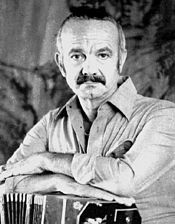
Tango, the music and lyrics (often sung in a slang called lunfardo), is Argentina's musical symbol. It has influences from the European and African culture. The golden age of tango (1930 to mid-1950s) mirrored that of jazz and swing in the United States, featuring large orchestral groups too, like the bands of Osvaldo Pugliese, Aníbal Troilo, Francisco Canaro, Julio de Caro and Juan d'Arienzo. Incorporating acoustic music and later, synthesizers into the genre after 1955, bandoneón virtuoso Ástor Piazzolla popularized "new tango" creating a more subtle, intellectual and listener-oriented trend. Today tango enjoys worldwide popularity; ever-evolving, neo-tango is a global phenomenon with renown groups like Tanghetto, Bajofondo and the Gotan Project.
Argentine rock developed as a distinct musical style in the mid-1960s, when Buenos Aires and Rosario became cradles of several garage groups and aspiring musicians. Today it is widely considered the most prolific and successful form of Rock en Español. Bands such as Soda Stereo or Sumo, and composers like Charly García, Luis Alberto Spinetta, and Fito Páez are referents of national culture. Serú Girán bridged the gap into the 1980s, when Argentine bands became popular across Latin America and elsewhere. Current popular bands include: Babasónicos, Rata Blanca, Horcas, Attaque 77, Bersuit, Los Piojos, Intoxicados, Catupecu Machu, Carajo and Miranda!.
Beyond dozens of regional dances, a national Argentine folk style emerged in the 1930s. Perón's Argentina would give rise to nueva canción, as artists began expressing in their music objections to political themes. The style went on to influence the entirety of Latin American music. Today, Chango Spasiuk and Soledad Pastorutti have brought folk back to younger generations. León Gieco's folk-rock bridged the gap between Argentine folklore and Argentine rock, introducing both styles to millions overseas in successive tours.
Following the emergence of "new tango" in the 1960s, one of Piazzolla's fellow bandoneónists he influenced most became a noted jazz composer in his own right. Rodolfo Mederos' 1976 album Fuera de broma 8 fused be-bop with tango and acoustic rock; Mederos has since recorded numerous albums and film scores. His success with jazz fusion inspired others, like fellow bandoneónist Dino Saluzzi, guitarist Lito Epumer and alto sax man Bernardo Baraj. Later in the 1970s and through the 1990s, drummer Pocho Lapouble became well known for his jazz trio and film scores. Argentine jazz saxophonists have also become prominent in their genre. Alto saxophonist Andrés Boiarsky, who emerged in 1986 performing the film score for Hombre mirando al sudeste (" Man Facing Southeast"), records extensively to this day, collaborating with Latin jazz greats like Paquito D'Rivera and Claudio Roditi. Carlos Franzetti's work and arrangements for the 1992 feature film, The Mambo Kings, earned him a Latin Grammy.
The best-known Argentine jazz musician internationally is probably Leandro Gato Barbieri. The tenor saxophonist worked with renowned big band orchestra conductor Lalo Schifrin in the early 1960s, shortly before Schifrin became internationally known for his composition of the theme to Mission: Impossible. Hired by jazz trumpeter Don Cherry, the two recorded Complete Communion in 1965, an album that secured their reputation in the jazz world. Barbieri went on to record his influential Caliente! (1976), an album combining Latin jazz and experimental work such as his own and jazz fusion great Carlos Santana's, as well as Qué pasa (1997), which draws more deeply from Argentine folklore roots.
Sports


The official national sport of Argentina is pato, played with a six-handle ball on horseback, but the most popular sport is association football. The national football team has won 25 major international titles including two FIFA World Cups, two Olympic gold medals and fourteen Copa Américas. Over one thousand Argentine players play abroad, the majority of them in European football leagues. There are 331,811 registered football players, with increasing numbers of girls and women, who have organized their own national championships since 1991 and were South American champions in 2006.
Football is the most popular sport in Argentina. It is part of the country's culture. The sport is played by children during breaks at school, and by adults in both indoor and outdoor fields located throughout the country.
The Argentina national football team has won the FIFA World Cup twice (in 1978 and 1986), successive Olympic gold medals (in 2004 and 2008), fourteen Copa América, one Confederations Cup, and six Youth World Championship's. Argentine clubs have won the Copa Libertadores (the top continental competition) a record 22 times, and have won the Intercontinental Cup or the FIFA Club World Cup 9 times, a record shared with Brazilian clubs. The Argentine Primera División is the top level domestic competition. The country's most famed national football idol historically is Diego Maradona.
Argentina's fiercest rival is Brazil. The rivalry is sometimes known as the Battle of the South Americans. They have played each other numerous times in the Copa América, and in the Confederation Cup, and the clubs of these countries have met several times in the Copa Libertadores finals. Argentina is one of the few national teams in football that have beat Brazil on a regular basis, although in the latest years, Brazil has turned the situation in its favour. The youth teams have also met at various tournaments. At the 2008 Summer Olympics, the under-23 teams met in the semi-final clash, with Argentina winning 3–0 in a hard-fought game. In addition, the abovementioned Maradona has been often compared with Brazilian iconic soccer player Pelé.
Women's football is far behind in terms of popularity and professionalism. Nevertheless, the Argentina women's national football team has competed in the Sudamericano Femenino since 1995, finishing as runner-up three times, before finally winning the competition in 2006, with a 5–0 victory over Brazil in the last match of the final group stage. The national team also played in the 2003 and the 2007 FIFA Women's World Cup, but finished last in its group on both occasions.
Basketball

Basketball is a very popular sport, mostly in the provinces of Argentina. The Basketball Clubs' Association organizes the Liga Nacional de Básquet, the top level of the country's league system. Although the Argentine national team won the first FIBA World Championship in 1950, the sport did not gain country-wide popularity until the 2000s, when the national team conquered the Olympic gold medal at the 2004 Summer Olympics, and had a good performance in the 2002 and 2006 World Championships, finishing respectively in second and fourth position. Argentine NBA star Emanuel Ginóbili also won NBA rings in 2003, 2005, and 2007, as a member of the San Antonio Spurs, the last one with compatriot Fabricio Oberto.
Though women's basketball is not professional in Argentina, the national team participates in most of the international competitions, reaching its highest point at the 2006 FIBA World Championship for Women, when they finished in 9th place.
Tennis
Tennis in Argentina is regulated by the Asociación Argentina de Tenis (Argentine Tennis Association), which also selects the coaches of the Argentine teams for the Davis Cup and Federation Cup.
Although British immigrants brought the sport to Argentina, it was not until 1977 that Guillermo Vilas' success made the sport popular, reaching second place in the 1975 ATP ranking. He was internationally recognised and was later included in the International Tennis Hall of Fame.
During the 1980s, José Luis Clerc (4th), Alberto Mancini (8th) and Martín Jaite (10th) followed Vilas and kept interest in the sport alive. Argentina won the 1980 World Team Cup beating Italy 3-0, and reached the final of the 1980 Davis Cup, losing to United States 3-1. In the 1990s it was Gabriela Sabatini who best represented Argentine tennis, becoming an international figure on and off the court.
The boom of Argentine tennis players came in the 2000s, when many players became important in the circuit reaching high ranks. Paola Suárez won eight Grand Slam doubles between 2001 and 2005 and was, together with Spaniard Virginia Ruano Pascual, the top women's couple for three years in a row.
In 2002, José Acasuso, Guillermo Cañas, Lucas Arnold and Gastón Etlis won again the World Team Cup for Argentina, this time 3-0 against Russia. Five years later, Acasuso, Juan Ignacio Chela, Agustín Calleri and Sebastián Prieto won it again, this time 2-1 against Czech Republic.
David Nalbandian lost in the final of Wimbledon in 2002. The 2004 French Open saw an Argentine final between Gastón Gaudio and Guillermo Coria. The following year's French Open saw Mariano Puerta reach the final.
Another example of the importance of the Argentine presence on the circuit was the August 2005 male rankings that counted five Argentine players among the top 12 (from 8th to 12th) of the ATP ranking, and three in the top ten of the Champions Race (5th, 8th and 9th). In April 2007, there were 13 Argentine male players in the ATP top 100, rivaling with the 13 Spanish, 12 French and 10 US citizens.
The 2005 Tennis Masters Cup, due to a series of last-minute resignations, had four Argentine players of the total of eight, with Gaudio reaching semi-finals, and Nalbandian winning.
In 2009 Juan Martin del Potro became the first Argentine to win the US Open since Guillermo Vilas did in 1977. That year Del Potro reached the final of the ATP World Tour Championship.
Field hockey
Las Leonas (Argentina's national women's team) is one of the usual contenders in all the premier tournaments in women's field hockey. They conquered the Women's World Hockey Cup in 2002 and 2010. In the Olympics, they won the silver medal in 2000, as well as bronze in 2004 and 2008. Also, Las Leonas won the annual Hockey Champions Trophy on five occasions, in 2001, 2008, 2009, 2010, and 2012.
In the other hand, the men's team hasn't been able to win any major tournament except for the hockey tournament at the Pan American Games in 8 occasions, although they won the 2005 and 2007 Champions Challenges, and are usually positioned among the top ten teams in the world, participating in the World Cup and Champions Trophies.
Luciana Aymar is the only player in history to receive the International Hockey Federation World Player of the Year award seven times.
Polo
Meanwhile, British settlers in the Argentine pampas started practising it during their free time. Among them, David Shennan is credited with having organised the first formal polo game of the country in 1875. The sport spread fast between the skilful gauchos and several clubs opened in the following years in the towns of Venado Tuerto, Cañada de Gómez, Quilmes, Flores and later (1888) Hurlingham. In 1892 The River Plate Polo Association was founded and constituted the basis for the current Asociación Argentina de Polo. In the Olympic Games held in Paris in 1924 a team composed by Juan Miles, Enrique Padilla, Juan Nelson, Arturo Kenny, G. Brooke Naylor and A. Peña won the gold medal. In Berlin in 1936, Argentina won with players Manuel Andrada, Andrés Gazzotti, Roberto Cavanagh, Luis Duggan, Juan Nelson, Diego Cavanagh and Enrique Alberdi.
From then on, the game spread nationwide. Argentina has the largest number ever of 10 handicap players in the world.
Argentina was host of the ninth edition of the World Polo Championship (for teams of up to 14 goals) at the Estancia Grande Polo Club, in the province of San Luis in October 2011.
National symbols
Argentina has a number of national symbols, some of which are extensively defined by law.
The National Flag consists of three, equal in width, horizontal stripes, colored light blue, white and light blue, with the Sun of May in the centre of the middle, white stripe. The flag was designed by Manuel Belgrano in 1812; it was adopted as a national symbol 20 July 1816. The Coat of Arms of Argentina, which represents the union of the provinces, came into use in 1813 as a seal for official documents.
The Argentine National Anthem, adopted in 1813, was written by Vicente López y Planes with music by Blas Parera. It has been subsequently shortened to only three paragraphs, after omitting the lyrics' attacks against former occupant Spain.
The Cockade of Argentina was first used during the May Revolution of 1810 and was made official two years later. The Hornero, habitating practically across all the national territory, was unanimously designated as Argentina's national animal in 1927. The ceibo is the country's designated national flower and tree, while the horseback game of pato is its national sport. The Schinopsis balansae was declared "National forest tree" in 1956. The Rhodochrosite is the national stone.
The national dishes are asado and locro, and wine the national liquor.
The Virgin of Lujan is Argentina's patron saint.


